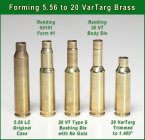Bat Rastard
Gold $$ Contributor
I am contemplating a Vartarg. I am wondering if this would work for forming brass from 223.
1. Buy a cheap (Lee) 221FB sizing die and remove the guts. Run well lubed brass until I have my shoulder in place.
2. Chop saw most of the excess neck.
3. Trim to length
4. Size in a Vartarg die.
1. Buy a cheap (Lee) 221FB sizing die and remove the guts. Run well lubed brass until I have my shoulder in place.
2. Chop saw most of the excess neck.
3. Trim to length
4. Size in a Vartarg die.











